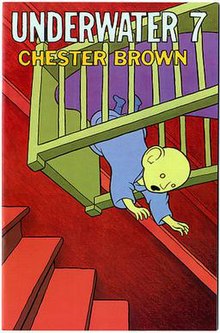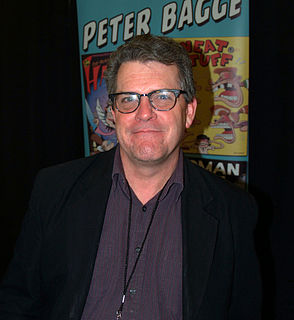
Peter Bagge is an American cartoonist whose best-known work includes the comics Hate and Neat Stuff. His stories often use black humor and exaggerated cartooning to dramatize the reduced expectations of middle-class American youth. He won two Harvey Awards in 1991, one for best cartoonist and one for his work on Hate. In recent decades Bagge has done more fact-based comics, everything from biographies to history to comics journalism. Publishers of Bagge's articles, illustrations, and comics include suck.com, MAD Magazine, toonlet, Discover, and the Weekly World News, with the comic strip Adventures of Batboy. He has expressed his libertarian views in features for Reason.

Franklin Christenson "Chris" Ware is an American cartoonist known for his Acme Novelty Library series and the graphic novels Jimmy Corrigan, the Smartest Kid on Earth (2000), Building Stories (2012) and Rusty Brown (2019). His works explore themes of social isolation, emotional torment and depression. He tends to use a vivid color palette and realistic, meticulous detail. His lettering and images are often elaborate and sometimes evoke the ragtime era or another early 20th-century American design style.
Autobiographical comics are autobiography in the form of comic books or comic strips. The form first became popular in the underground comix movement and has since become more widespread. It is currently most popular in Canadian, American and French comics; all artists listed below are from the US unless otherwise specified.
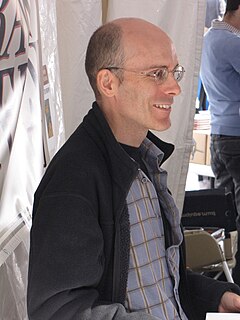
Chester William David Brown is a Canadian cartoonist.

Drawn & Quarterly is a publishing company based in Montreal, Quebec, Canada, specializing in comics. It publishes primarily comic books, graphic novels and comic strip collections. The books it publishes are noted for their artistic content, as well as the quality of printing and design. The name of the company is a pun on "drawing", "quarterly", and the practice of hanging, drawing and quartering. Initially it specialized in underground and alternative comics, but has since expanded into classic reprints and translations of foreign works. Drawn & Quarterly was the company's flagship quarterly anthology during the 1990s.
Joe Matt is an American cartoonist, best known for his autobiographical work, Peepshow.
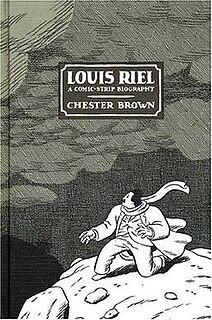
Louis Riel is a historical biography in comics by Canadian cartoonist Chester Brown, published as a book in 2003 after serializion in 1999–2003. The story deals with Métis rebel leader Louis Riel's antagonistic relationship with the newly established Canadian government. It begins shortly before the 1869 Red River Rebellion, and ends with Riel's 1885 hanging for high treason. The book explores Riel's possible schizophrenia—he believed God had named him Prophet of the New World, destined to lead the Métis people to freedom.

Yummy Fur (1983–1994) was a comic book by Canadian cartoonist Chester Brown. It contained a number of different comics stories which dealt with a wide variety of subjects. Its often-controversial content led to one printer and one distributor refusing to handle it.
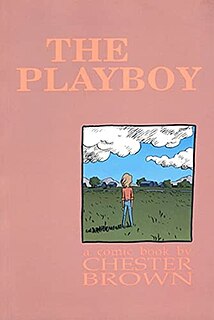
The Playboy is a graphic novel by Canadian cartoonist Chester Brown, serialized in 1990 in Brown's comic book Yummy Fur and collected in different revised book editions in 1992 and 2013. It deals with Brown's guilt and anxiety over his obsessive masturbation to Playboy Playmate models.
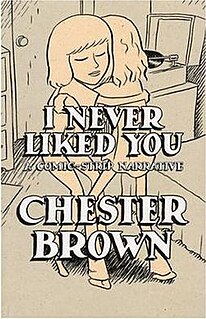
I Never Liked You is a graphic novel by Canadian cartoonist Chester Brown. The story first ran between 1991 and 1993 under the title Fuck, in issues #26–30 of Brown's comic book Yummy Fur; published in book form by Drawn & Quarterly in 1994. It deals with the teenage Brown's introversion and difficulty talking to others, especially members of the opposite sex—including his mother. The story has minimal dialogue and is sparsely narrated. The artwork is amongst the simplest in Brown's body of work—some pages consist only of a single small panel.

Ed the Happy Clown is a graphic novel by Canadian cartoonist Chester Brown. Its title character is a large-headed, childlike children's clown who undergoes one horrifying affliction after another. The story is a dark, humorous mix of genres and features scatological humour, sex, body horror, extreme graphic violence, and blasphemous religious imagery. Central to the plot are a man who cannot stop defecating; the head of a miniature, other-dimensional Ronald Reagan attached to the head of Ed's penis; and a female vampire who seeks revenge on her adulterous lover who had murdered her to escape his sins.

Vortex Comics is a Canadian independent comic book publisher that began operation in 1982. Under the supervision of president, publisher, and editor Bill Marks, Vortex was known for such titles as Dean Motter's Mister X, Howard Chaykin's Black Kiss, and Chester Brown's Yummy Fur, the last of which was a pioneer of alternative comics. Vortex also earned a reputation for publishing Canadian comic book creators such as Brown, Ty Templeton, Ken Steacy, and Jeffrey Morgan.

The Little Lulu Library is an 18-volume deluxe hardcover series of books reprinting a long run of Little Lulu comics from the period when John Stanley was writing the stories. Most of the stories collected were drawn by either Stanley or Irving Tripp. At the time they were published, they were the only Little Lulu comics that were in print in the English language.

The Little Man: Short Strips 1980–1995 is a collection of short works by award-winning Canadian cartoonist Chester Brown, published by Drawn & Quarterly in 1998. It collects most of Brown's non-graphic novel short works up to that point, with the notable exception of his incomplete adaptations of the Gospels.

Paying for It, "a comic strip memoir about being a john", is a 2011 graphic novel by Canadian cartoonist Chester Brown. A combination of memoir and polemic, the book explores Brown's decision to give up on romantic love and to take up the life of a "john" by frequenting prostitutes. The book, published by Drawn & Quarterly, was controversial, and a bestseller.

Chester Brown adapted Gospel of Mark and part of the Gospel of Matthew to comics; installments appeared in his comic books Yummy Fur and Underwater. Brown ran the first installment of the Gospel of Mark in Yummy Fur #4 in 1987, and left Matthew unfinished after cancelling Underwater in 1997. Brown had planned to do all four of the canonical gospels, but in 2011 stated that it is unlikely he will finish even Matthew.
Canadian cartoonist Chester Brown attracted the attention of critics and peers in the early 1990s alternative comics world when he began publishing autobiographical comics in his comic book Yummy Fur. During this period Brown produced a number of short strips and two graphic novels: The Playboy (1992) and I Never Liked You (1994). The personal and revealing deal with Brown's social awkwardness and introversion, and the artwork and page layouts are minimal and organic. In 2011 Brown returned to autobiography with Paying for It, an account of his experience with prostitutes.
Canadian comics refers to comics and cartooning by citizens of Canada or permanent residents of Canada regardless of residence. Canada has two official languages, and distinct comics cultures have developed in English and French Canada. The English tends to follow American trends, and the French, Franco-Belgian ones, with little crossover between the two cultures. Canadian comics run the gamut of comics forms, including editorial cartooning, comic strips, comic books, graphic novels, and webcomics, and are published in newspapers, magazines, books, and online. They have received attention in international comics communities and have received support from the federal and provincial governments, including grants from the Canada Council for the Arts. There are comics publishers throughout the country, as well as large small press, self-publishing, and minicomics communities.

Michael DeForge is a Canadian comics artist and illustrator.
Seth’s Dominion is a 2014 National Film Board of Canada animated/live action documentary directed by Luc Chamberland about the Canadian cartoonist Seth.
